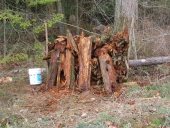








Certifiable food forest gardener, free gardening advice offered and accepted. Permaculture is the intersection of environmentalsim and agriculture.




The ultimate goal of farming is not the growing of crops, but the cultivation and perfection of human beings. - Masanobu Fukuoka




I have never met a stranger, I have met some strange ones.








1. my projects
















Get involved -Take away the standing of corporations MovetoAmmend.org









Steven Smallwood wrote:This is my second time posting. Last time, I was not on the property I would be working with. Now, I am here for the summer, then leaving for a short break in August, and then coming back to live here.
I have taken pictures of the property to give a sense of what I have to this forum. I would love to hear suggestions after you read what I briefly have to say.
8. I am putting my life into this property. I want to change it all into producing land. I'm 23, no health problems, just back from living in a huge city for over 2 years. I would like to get fruit trees growing as soon as possible. I am thinking of planning out everywhere I want to dig swales, and piling wood everywhere I am going to want hugelkulturs, then renting equipment to move the earth in one or two days. What do you think?
"Limitation is the mother of good management", Michael Evanari
Location: Southwestern Oregon (Jackson County), Zone 7








































Our projects:
in Portugal, sheltered terraces facing eastwards, high water table, uphill original forest of pines, oaks and chestnuts. 2000m2
in Iceland: converted flat lawn, compacted poor soil, cold, windy, humid climate, cold, short summer. 50m2




Idle dreamer

|
Farmers know to never drive a tractor near a honey locust tree. But a tiny ad is okay:
The new kickstarter is now live!
https://www.kickstarter.com/projects/paulwheaton/garden-cards
|







